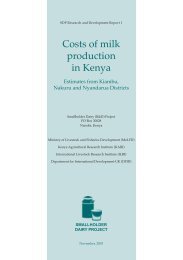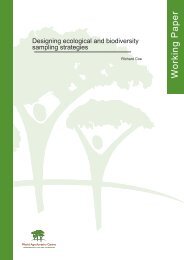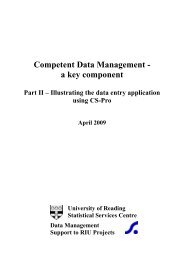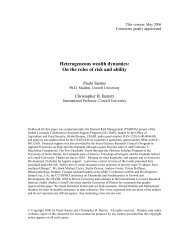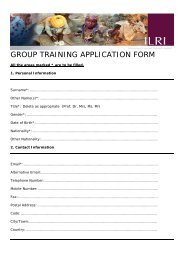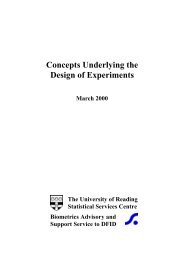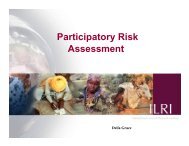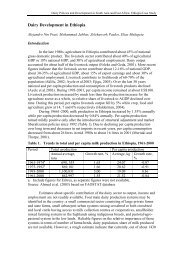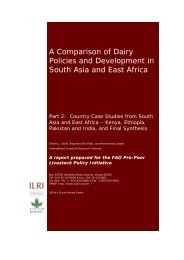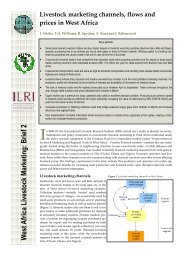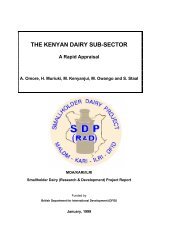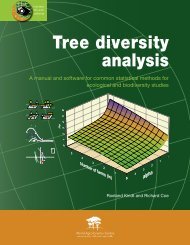Educational, research and extension <strong>in</strong>stitutions <strong>in</strong> the prov<strong>in</strong>ce are l<strong>in</strong>ked closely to each other and tothe civil/political structure for identification <strong>of</strong> problems and the generation and diffusion <strong>of</strong> technologies t<strong>of</strong>armers. The CAAS conducts research on issues <strong>of</strong> national importance, whilst the Hunan Academy <strong>of</strong>Agricultural Sciences (HAAS) is <strong>in</strong>volved with prov<strong>in</strong>cial issues and, to a lesser extent, national issues.Feed supply is the pr<strong>in</strong>cipal constra<strong>in</strong>t. Although diseases are not a major problem, they do occur andare the same as those encountered <strong>in</strong> other countries <strong>in</strong> the region. For example, the major disease <strong>of</strong> pigs issw<strong>in</strong>e fever and, for poultry, Newcastle disease. Cattle and goats are affected by a range <strong>of</strong> <strong>in</strong>ternal parasites.For certa<strong>in</strong> diseases, mass vacc<strong>in</strong>ation is carried out twice a year, and each village has a veter<strong>in</strong>ary stationthat is l<strong>in</strong>ked to a network throughout the prov<strong>in</strong>ce. Services are free but farmers pay for drugs and vacc<strong>in</strong>es.Private companies manag<strong>in</strong>g large farms, however, also pay for veter<strong>in</strong>ary services.No erosion was evident <strong>in</strong> the rice-grow<strong>in</strong>g areas <strong>in</strong> the lowlands. Terraces and bunds were present onall <strong>of</strong> the cultivated land. In the uplands, erosion has occurred and has been associated <strong>in</strong> some areas withovergraz<strong>in</strong>g. Terrac<strong>in</strong>g is be<strong>in</strong>g practised <strong>in</strong> these areas together with the plant<strong>in</strong>g <strong>of</strong> trees.Major challenges for the future <strong>in</strong>clude environmental protection and related resource management, thedevelopment <strong>of</strong> animal feeds without chemical additives, the improved efficiency <strong>of</strong> livestock production,disease prevention and the creation <strong>of</strong> process<strong>in</strong>g and market<strong>in</strong>g <strong>in</strong>frastructure to meet the rapidly ris<strong>in</strong>gdemand for better-quality animal products. In order to tackle these problems, a more multidiscipl<strong>in</strong>aryapproach to research and technology evaluation and dissem<strong>in</strong>ation will be required. More economic analysis<strong>of</strong> technology options and their impacts, and assessments <strong>of</strong> market potential for <strong>in</strong>puts, technologies andproducts need to be conducted. Economists from the Agricultural Economics Research Institute <strong>in</strong> HAASparticipate <strong>in</strong> some <strong>of</strong> the work, but the number <strong>of</strong> economists may need to be <strong>in</strong>creased as the market becomesthe key determ<strong>in</strong>ant <strong>of</strong> resource-allocation decisions by producers and consumers.Guangdong and Ha<strong>in</strong>an prov<strong>in</strong>cesFarm<strong>in</strong>g systems <strong>in</strong> South Ch<strong>in</strong>a (Guangdong and Ha<strong>in</strong>an) <strong>in</strong>volve ma<strong>in</strong>ly <strong>in</strong>tensive rice production <strong>in</strong> thelowlands with peanut, soyabean and mungbean grown as cash crops (Devendra and Sere 1993). In the uplands<strong>of</strong> Ha<strong>in</strong>an Prov<strong>in</strong>ce rubber, tea, fruit, cassava and sweet potato are grown and there is <strong>in</strong>tensive vegetableproduction <strong>in</strong> the lowlands. Typical cropp<strong>in</strong>g patterns <strong>in</strong> South Ch<strong>in</strong>a <strong>in</strong>clude wheat–soyabean/peanut–rice(uplands); wheat–rice–rice; sweet potato–rice–rice; maize–rice; and rice/jute–rice.In animal production systems, non-rum<strong>in</strong>ants (pigs, poultry and ducks) are the most important animalsfollowed by cattle, buffaloes and goats. Buffaloes are important for land preparation and haulage.Considerable opportunities exist <strong>in</strong> Ha<strong>in</strong>an Prov<strong>in</strong>ce for the production <strong>of</strong> goat meat, where prices areappreciably higher than those for pigs or cattle, and there is a special consumer market <strong>in</strong> the urban areas.The major feed for rum<strong>in</strong>ants is native pasture on marg<strong>in</strong>al land and <strong>in</strong> rice-fields after harvest. Rice strawis utilised <strong>in</strong> the dry season, but treatment with urea is not yet a widespread practice.Until 1988, Ha<strong>in</strong>an was part <strong>of</strong> Guangdong Prov<strong>in</strong>ce and the work on pastures and forages had acommon focus. Tropical pasture technology was <strong>in</strong>troduced <strong>in</strong>to Guangdong Prov<strong>in</strong>ce <strong>in</strong> 1981, where arange <strong>of</strong> grasses (e.g. molasses grass, paspalum, setaria) and legumes (e.g. stylos, siratro, greenleafdesmodium) were tested. Stylos were <strong>in</strong>ter-cropped with fruit trees <strong>in</strong> hilly areas and leaf-meal wasproduced for non-rum<strong>in</strong>ants. The <strong>in</strong>clusion <strong>of</strong> legumes was expected to improve soil fertility and controlsoil erosion. In 1995, there were 200,000 ha <strong>of</strong> improved pastures <strong>in</strong> Guangdong Prov<strong>in</strong>ce, <strong>of</strong> which 80%was stylo. Pasture evaluation on Ha<strong>in</strong>an Island identified stylo CIAT 184 as the outstand<strong>in</strong>g cultivar.S<strong>in</strong>ce becom<strong>in</strong>g separate territories, divergence <strong>of</strong> effort is evident. In Guangdong Prov<strong>in</strong>ce, where theaverage farm size is 0.5 ha, competition for land and the greater efficiency <strong>of</strong> non-rum<strong>in</strong>ants has resulted<strong>in</strong> a strong emphasis on pigs and poultry at the expense <strong>of</strong> rum<strong>in</strong>ants. This trend is expected to accelerate<strong>in</strong> the future. Farmers are diversify<strong>in</strong>g <strong>in</strong>to fruit production and animal agriculture, but the importance <strong>of</strong>non-rum<strong>in</strong>ants is <strong>in</strong>dicat<strong>in</strong>g that rum<strong>in</strong>ant production is not a viable option. Accord<strong>in</strong>gly, opportunitiesfor rum<strong>in</strong>ants and pasture development exist primarily <strong>in</strong> Ha<strong>in</strong>an Prov<strong>in</strong>ce. On the coast, for example,there are significant areas <strong>of</strong> marg<strong>in</strong>al lands that could be developed for improved pastures, whilst foragelegumes could be <strong>in</strong>tegrated with vegetable production and rubber. Ha<strong>in</strong>an Prov<strong>in</strong>ce lies between latitudes
18–21° North, with an average ra<strong>in</strong>fall <strong>of</strong> 1700 mm occurr<strong>in</strong>g between May and October. Averagetemperature is 23°C and altitudes range from sea-level to 1867 m.The development <strong>of</strong> stylo for seed and leaf-meal <strong>in</strong> Ha<strong>in</strong>an Prov<strong>in</strong>ce is impressive. Seed production <strong>of</strong>stylo is based on state farms where the species is managed as an annual crop and fertilised with both manureand superphosphate. When stands are 85% ripe the plants are cut, with 30% <strong>of</strong> the seeds harvested from thecut plants. The rema<strong>in</strong><strong>in</strong>g 70% <strong>of</strong> the seeds are recovered from the ground by sweep<strong>in</strong>g up the soil forprocess<strong>in</strong>g. The stalks are also produced <strong>in</strong>to meal for non-rum<strong>in</strong>ants, but the quality is poor. There is oneharvest per year yield<strong>in</strong>g 375 kg/ha <strong>of</strong> seed. The operation is apparently highly pr<strong>of</strong>itable though rigorouseconomic analyses have not been conducted. For stylo leaf-meal production, the hay is dried for 2–3 daysbefore be<strong>in</strong>g milled. The average crude prote<strong>in</strong> content <strong>in</strong> the dry matter is about 12–13%. The leaf-meal isused ma<strong>in</strong>ly for non-rum<strong>in</strong>ants. Meal from Leucaena leucocephala leaf is also be<strong>in</strong>g produced on state farms.Further evaluation <strong>of</strong> legumes is tak<strong>in</strong>g place through collaboration between the FSP and the Ch<strong>in</strong>eseAcademy <strong>of</strong> Tropical Agricultural Sciences <strong>in</strong> Ha<strong>in</strong>an Prov<strong>in</strong>ce. These <strong>in</strong>clude various accessions <strong>of</strong> styloand perennial peanut. If the potential for goat production is realised, evaluation <strong>of</strong> multipurpose treegermplasm would be justified.IndonesiaEnvironment and cropp<strong>in</strong>g systemsThe Indonesian archipelago consists <strong>of</strong> over 13,000 islands with a land area <strong>of</strong> 1.8 million km 2 , <strong>of</strong> whichKalimantan is the largest cover<strong>in</strong>g 28% <strong>of</strong> the total land area. Java, although represent<strong>in</strong>g only 6–7% <strong>of</strong> thetotal land area, is the most densely populated island with close to 60% <strong>of</strong> the population <strong>of</strong> Indonesia. TheAEZs are well-def<strong>in</strong>ed and vary from the humid coastal swamps and wetlands <strong>in</strong> parts <strong>of</strong> Java, Sumatera,Kalimantan, south Sulawesi and Bali, to the sub-humid and semi-arid drylands <strong>in</strong> parts <strong>of</strong> Java, and onSulawesi and the Nusa Tenggara islands <strong>of</strong> Lombok, Simbawa, Suraba and Timur (Djajanegara and Diwyanto1995). Some 58% <strong>of</strong> the archipelago has seven to n<strong>in</strong>e consecutive wet months and less than two months <strong>of</strong>dry season. The lowest ra<strong>in</strong>fall areas are found <strong>in</strong> eastern Indonesia, where the dry season varies from threeto eight months. The temperature stays with<strong>in</strong> constant ranges, differ<strong>in</strong>g only <strong>in</strong> a few degrees between thehottest and coolest months. The farm<strong>in</strong>g systems are regulated more by ra<strong>in</strong>fall than temperature. Plantationcrops are associated with the wetter western areas, and more extensive grasslands with the drier easternregions.<strong>Crop</strong>s are produced on about 29 million ha out <strong>of</strong> 130 million ha <strong>of</strong> available arable land. About 9.0million ha are drylands and 8.0 million ha are wetlands <strong>in</strong>clud<strong>in</strong>g ra<strong>in</strong>fed areas suitable for rice cultivation.About 7.0 million ha are planted to perennial crops, and secondary crops cover more than 5.0 million ha. Themajority <strong>of</strong> animals are associated with cropp<strong>in</strong>g <strong>in</strong> smallholder systems.Soil fertility is strongly affected by climate and is a major constra<strong>in</strong>t to agricultural production. Heavyra<strong>in</strong>fall leads to soil erosion and high temperatures contribute to chemical weather<strong>in</strong>g. Soils are mostly ultisolsand oxisols, characterised by high levels <strong>of</strong> alum<strong>in</strong>ium but low contents <strong>of</strong> available nutrients. Soils <strong>in</strong> theeastern part <strong>of</strong> the archipelago are generally too poor to support <strong>in</strong>tensive cropp<strong>in</strong>g without the addition <strong>of</strong>fertilisers.Rice is the dom<strong>in</strong>ant food crop, particularly <strong>in</strong> the wetlands and swamps. The country has beenself-sufficient <strong>in</strong> rice s<strong>in</strong>ce 1984, and average yields are amongst the highest for all three rice cultures.Traditionally, rice is mono-cropped but multiple-cropp<strong>in</strong>g patterns based on <strong>in</strong>ter-cropp<strong>in</strong>g andsequential-cropp<strong>in</strong>g are now common. Other major crops are maize, cassava, sweet potato, soyabean and peanut.Perennial tree crops, especially rubber, are <strong>in</strong>cluded <strong>in</strong> smallholder systems. In the transmigration areas <strong>of</strong> southSumatera, vegetables, fruit, cassava and pulses are grown <strong>in</strong> the home gardens; rice and legumes on the food-cropland; and rubber as the pr<strong>in</strong>cipal plantation crop. Rubber production is lucrative and provides a regular <strong>in</strong>comeas well as be<strong>in</strong>g less labour-<strong>in</strong>tensive than food crop production. Farmers are <strong>in</strong>creas<strong>in</strong>g their areas <strong>of</strong> rubber forthese reasons, and reduc<strong>in</strong>g the area <strong>of</strong> food crops. Maize is sometimes <strong>in</strong>ter-cropped with rice, and cassava andp<strong>in</strong>eapple planted as borders. Rice with soyabean is a popular rotation <strong>in</strong> some areas.
- Page 2 and 3:
Affiliation of Authors:Dr C. Devend
- Page 4 and 5:
6.Strategyfor researchJustification
- Page 7 and 8:
AcknowledgementsThe International L
- Page 9 and 10:
esearch opportunities appropriate t
- Page 11 and 12:
Table 1.Animal populations and meat
- Page 13 and 14:
Introduction2. Characterisation and
- Page 15 and 16: Figure 2. Sub-humid tropics and sub
- Page 17 and 18: Table 3.Human and animal population
- Page 19 and 20: Table 5. Rice-growing environments
- Page 21 and 22: Multiple upland annual crop systems
- Page 23 and 24: Table 6. Continued.Country Importan
- Page 25 and 26: It should be noted that, compared w
- Page 27 and 28: Table 8.CountryCambodiaChinaIndones
- Page 29 and 30: of non-renewable fossil fuels and t
- Page 31 and 32: Overview of researchThere was a sur
- Page 33 and 34: • Identification of alternative c
- Page 35 and 36: Various animal production systems t
- Page 37 and 38: Presently, much of the vegetable pr
- Page 39 and 40: Table 10. Summary of the main socio
- Page 41 and 42: Table 11. Institutions and organisa
- Page 43 and 44: 3. In the ASEAN sub-region, inadequ
- Page 45 and 46: Table 12. Continued.SituationsPract
- Page 47 and 48: 6. Strategy for researchJustificati
- Page 49 and 50: Table 13. Priorities for research a
- Page 51 and 52: VietnamResearch capacity in NARS is
- Page 53 and 54: CRIFC (Central Research Institute f
- Page 55 and 56: IAS. 1995. Proceedings of the Works
- Page 57 and 58: Systems of sub-Saharan Africa. Volu
- Page 59 and 60: or waterlogged in the wet season an
- Page 61 and 62: Table A1. Important diseases of ani
- Page 63 and 64: • Increased cropping intensities,
- Page 65: the animal output came from pigs al
- Page 69 and 70: In the Nusa Tenggara islands, signi
- Page 71 and 72: Women work 11.5 h/day on average co
- Page 73 and 74: Various Australian forage projects
- Page 75 and 76: village production systems; to stud
- Page 77 and 78: The availability of feed in rubber
- Page 79 and 80: of the Ayeyarwady and Sittang river
- Page 81 and 82: Constraints and opportunitiesInadeq
- Page 83 and 84: gaining in importance, and signific
- Page 85 and 86: Table A3. Characterisation of crop-
- Page 87 and 88: Table A4. Interventions in crop-ani
- Page 89 and 90: Table A4. Continued.Project TitleGo
- Page 91 and 92: otations are practised, and there a
- Page 93 and 94: such as abortion. Vaccination cover
- Page 95 and 96: large areas of forests (3.4 million
- Page 97 and 98: Table A6. Some animal diseases repo
- Page 99 and 100: Appendix IIItineraryThe Philippines
- Page 101 and 102: 26 November 1996 am Visit to small
- Page 103 and 104: Appendix IIIList of persons metPhil
- Page 105 and 106: Mr Chhiv Nan, Acting Director, Depa
- Page 107 and 108: Dr U Maung Ngint, Managing Director
- Page 109: List of acronymsAARDACIARADBAEZAIBP



